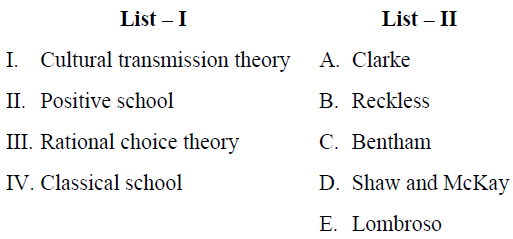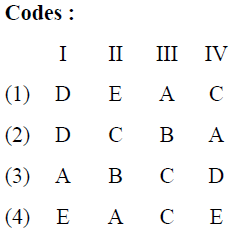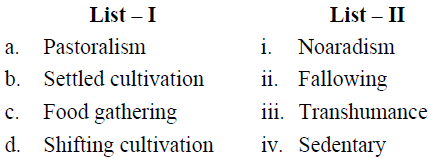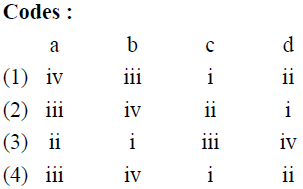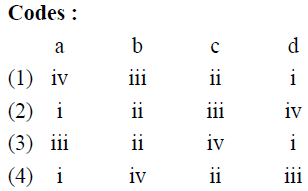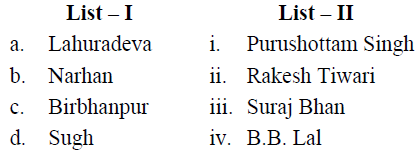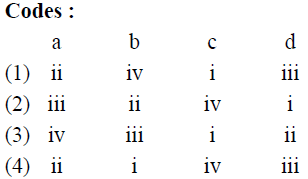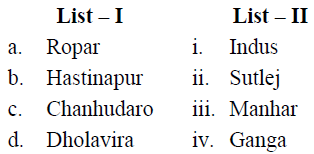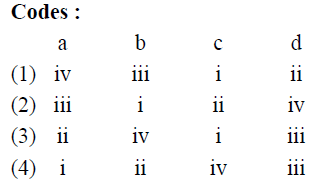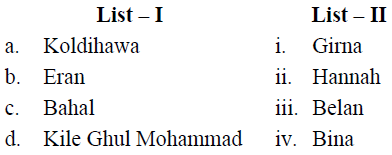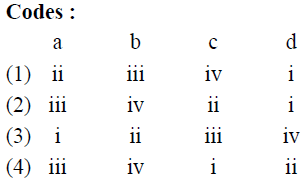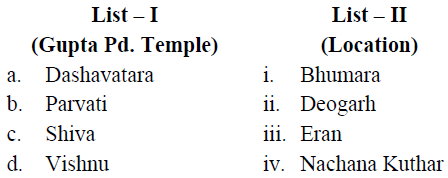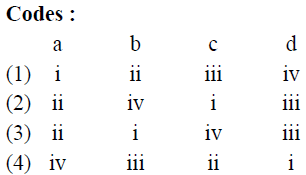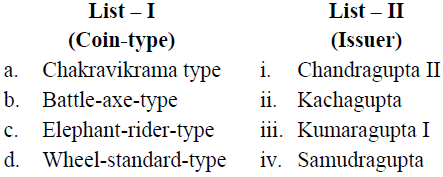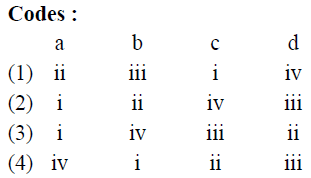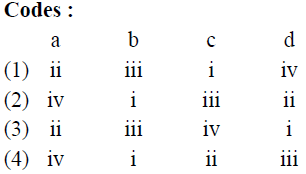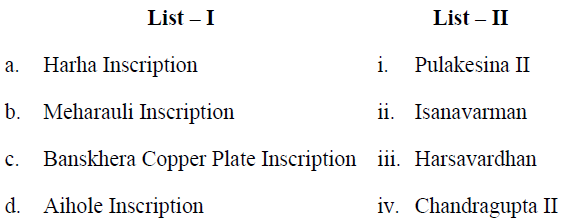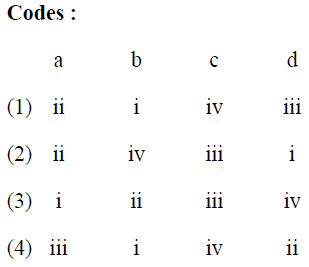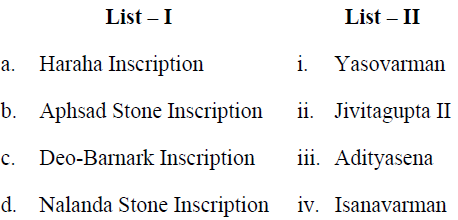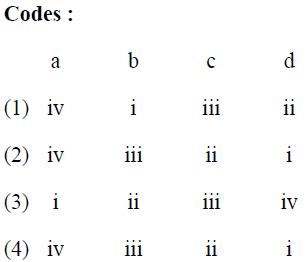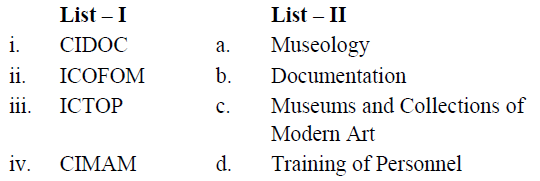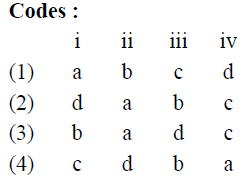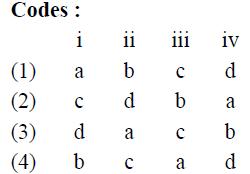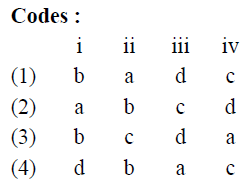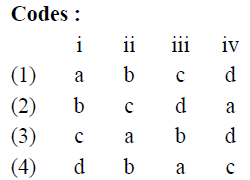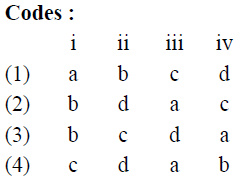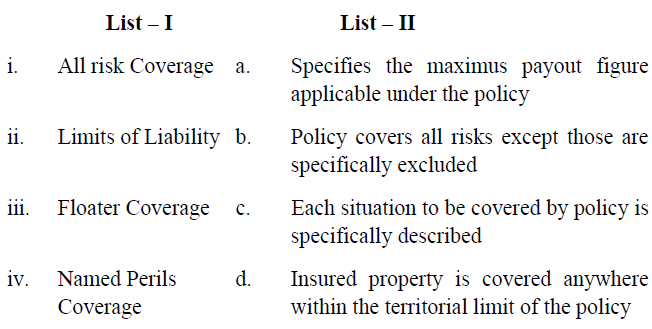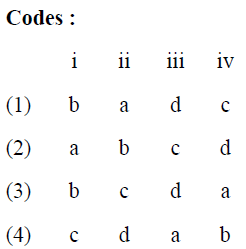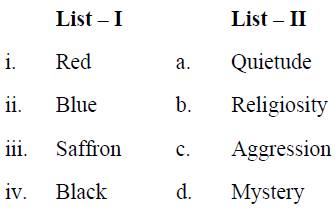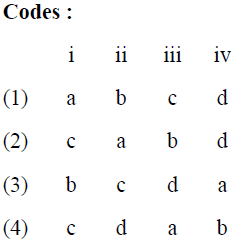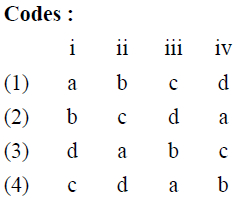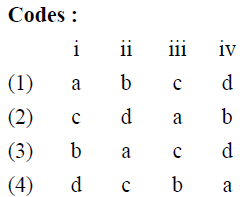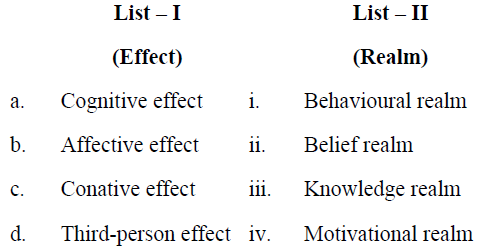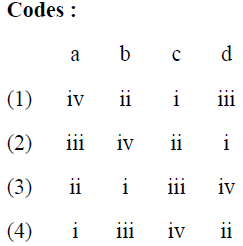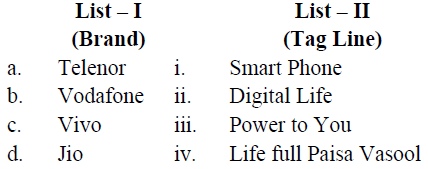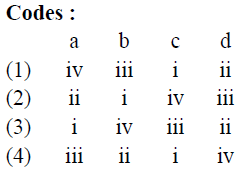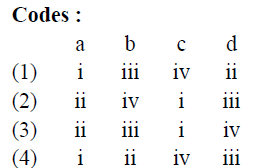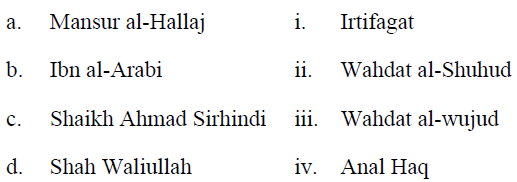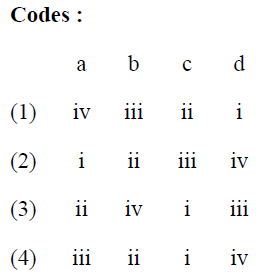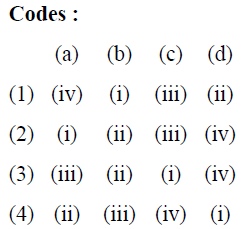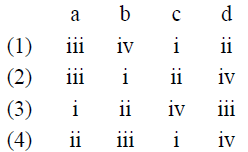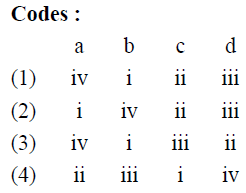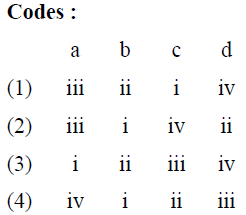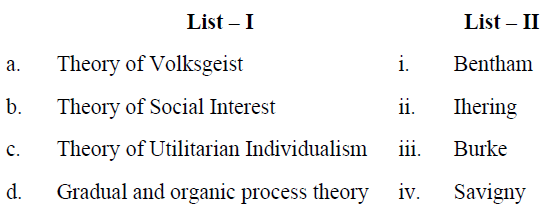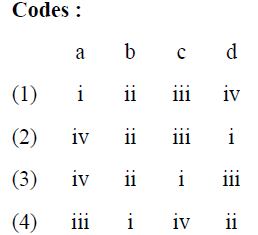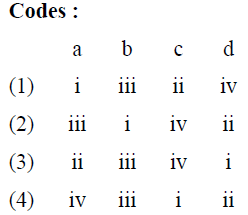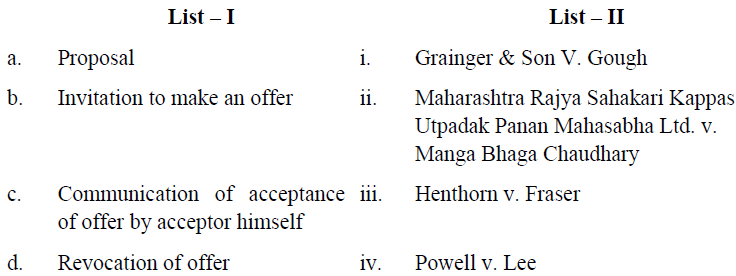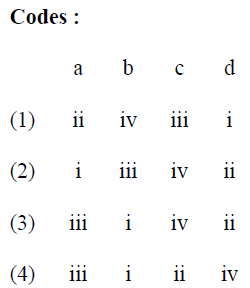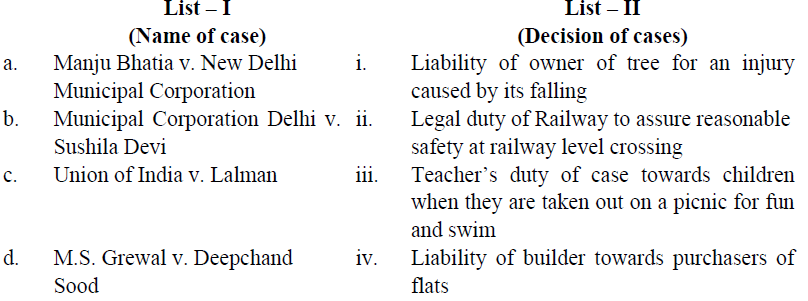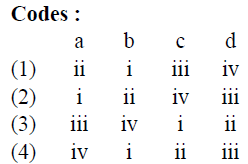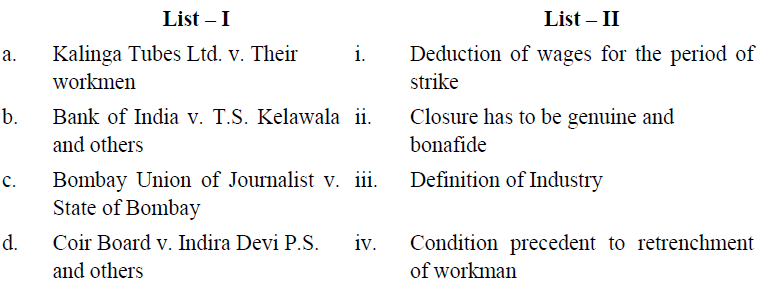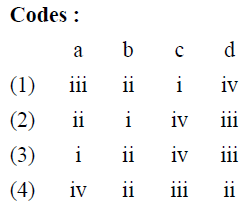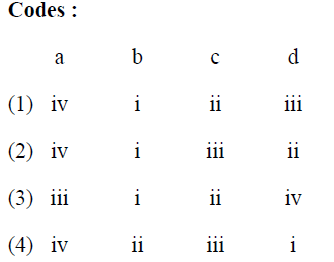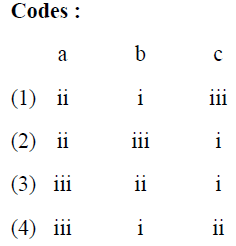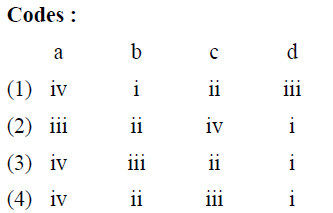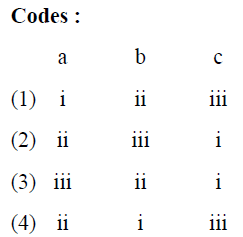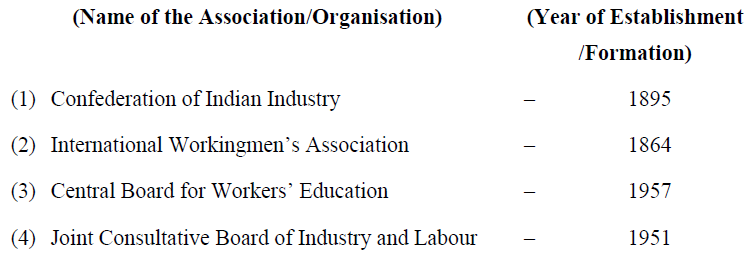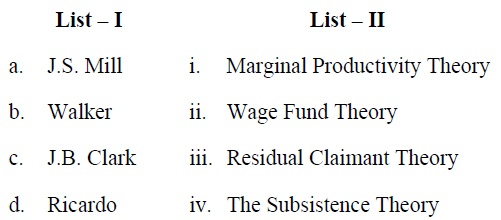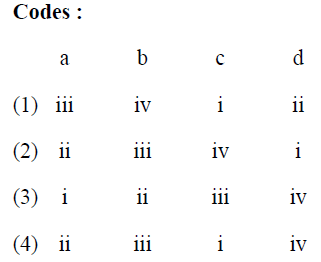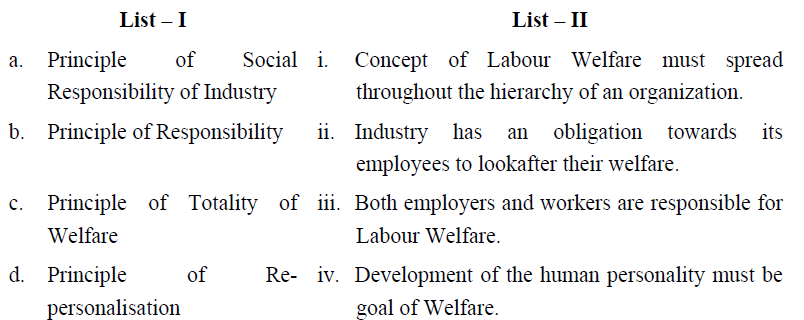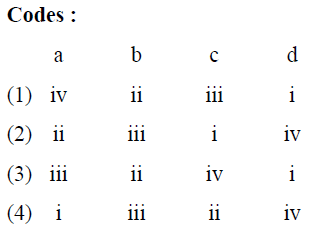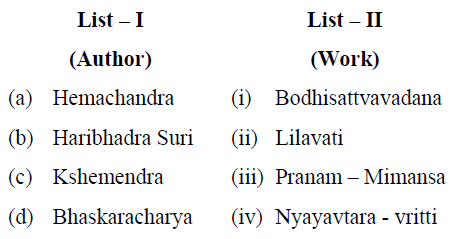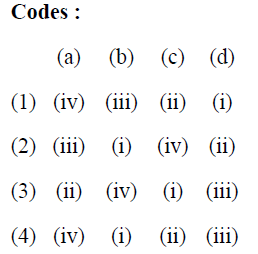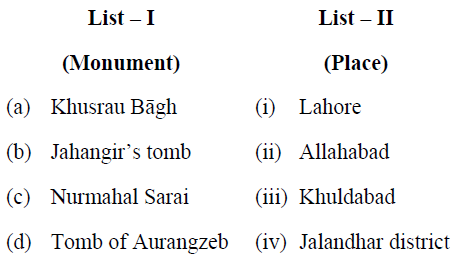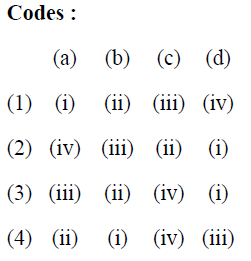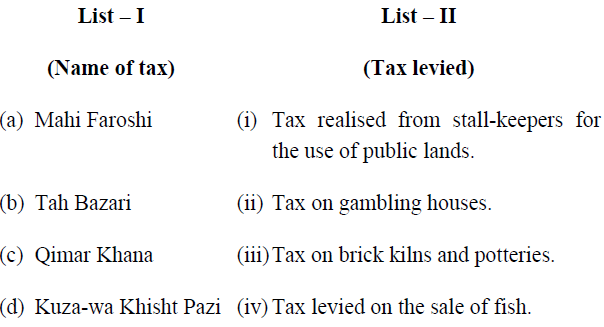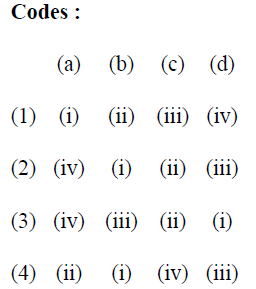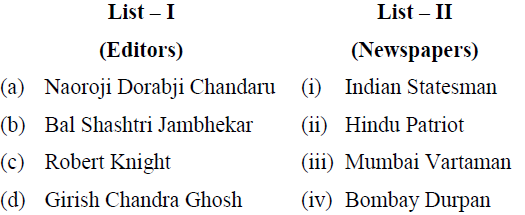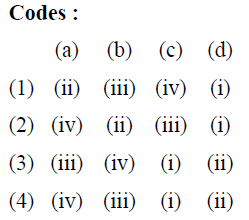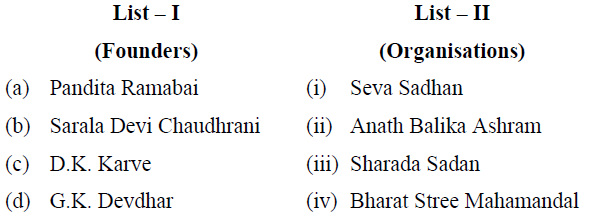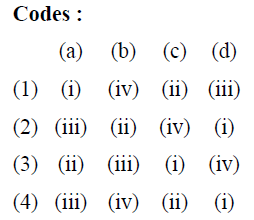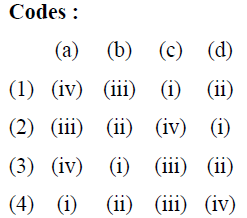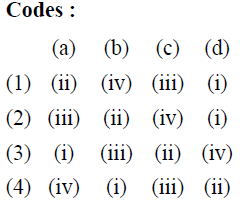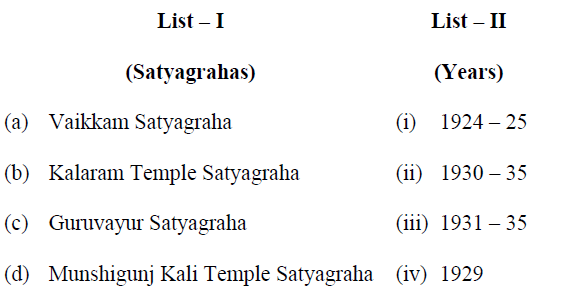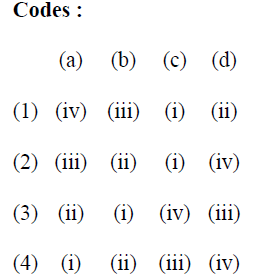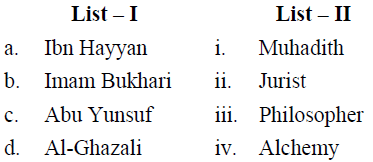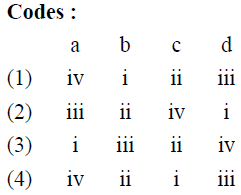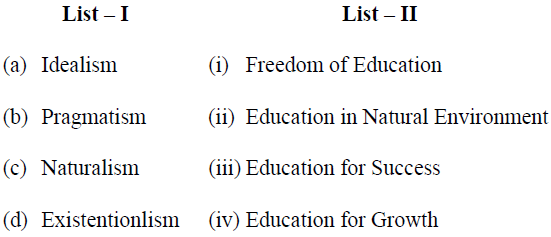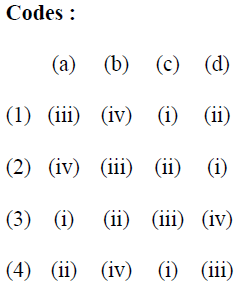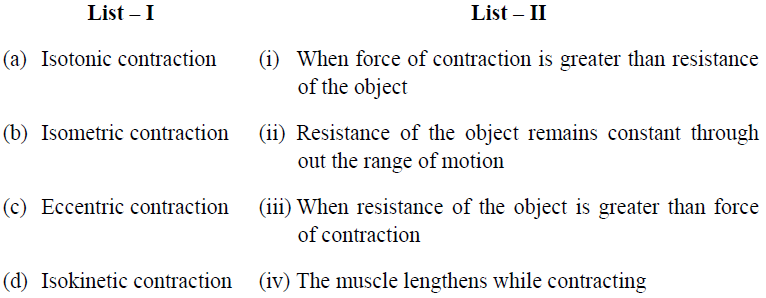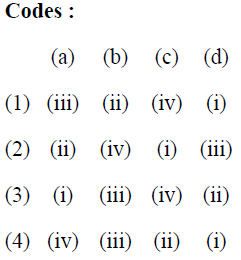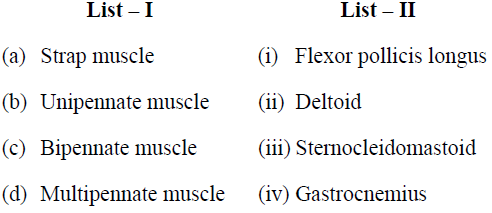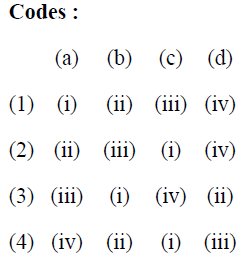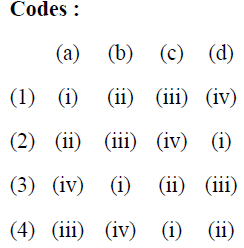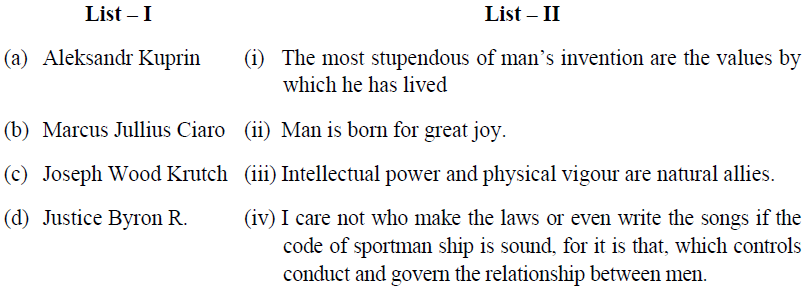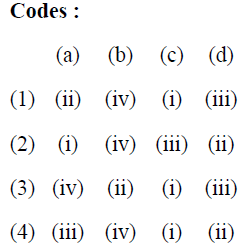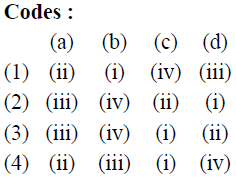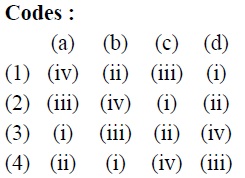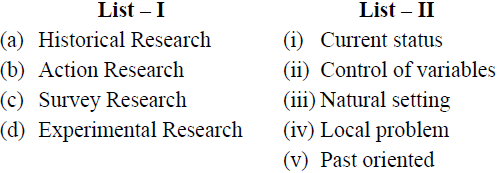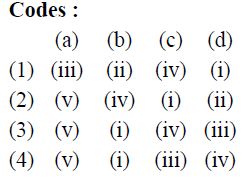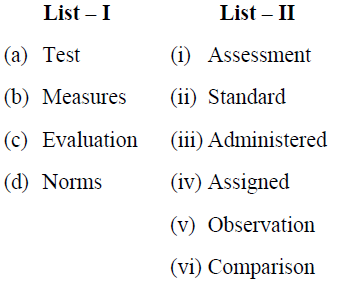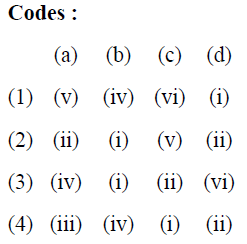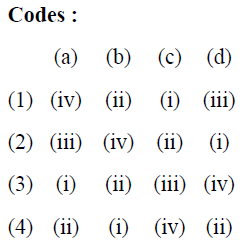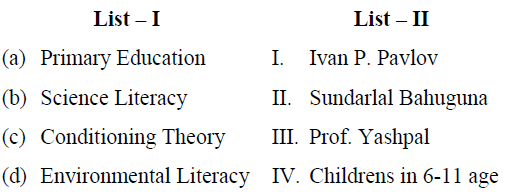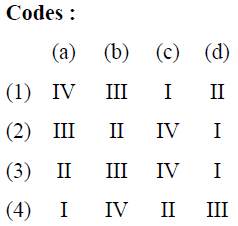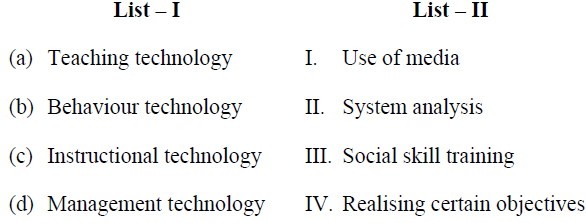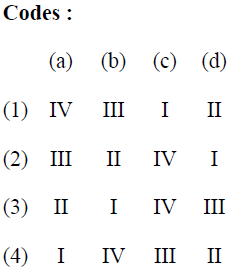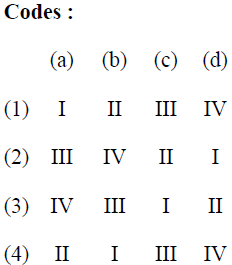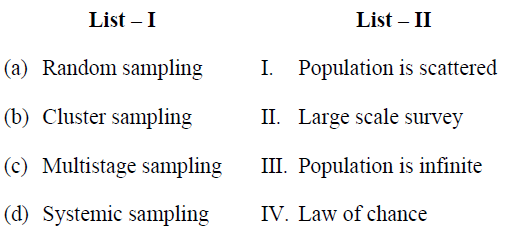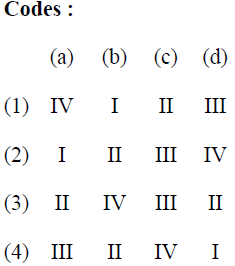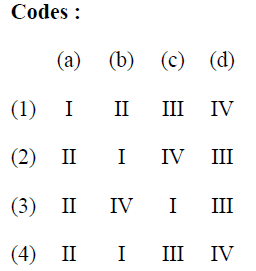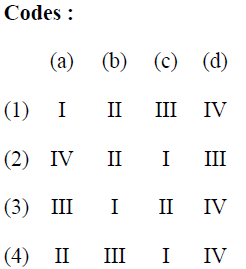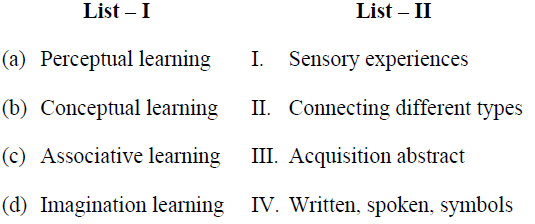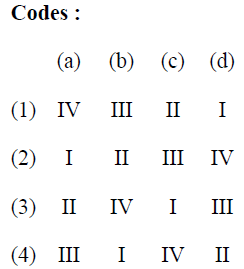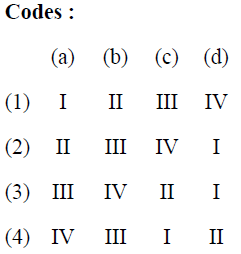WOMEN’S STUDIES
Paper – II
Note : This paper contains fifty (50) objective type questions of two (2) marks each. All questions are compulsory.
1. Which one of the following Universities first started a course on Women’s Studies ?
(1) San Diego State University
(2) Cornell University
(3) S.N.D.T. University
(4) Oxford University
2. Gender sensitive curriculum refers to that type of curriculum which
(1) has separate provision for women students.
(2) excludes Boys not to learn gender issues.
(3) attempts to challenge the gender stereotypes.
(4) includes only women’s issues.
3. Dual systems feminism suggests that women’s oppression is linked to a mixture of which of the following ?
(1) Gender and Sex
(2) Capitalism and Biology
(3) Culture and Patriarchy
(4) Capitalism and Patriarchy
4. Which of the feminist ideology attempts to revalidate ‘female nature or female essence’ ?
(1) Radical feminism
(2) Liberal feminism
(3) Cultural feminism
(4) Subaltern feminism
5. Who coined the slogan “The personal is Political, “Which became synonymous with the Second Wave Feminism ?
(1) Gamal Abdel Nasser
(2) Simon de Beauvoir
(3) Carol Hanisch
(4) Susan B. Anthony
6. Which of the following variable is most critical for those who focus on gender oppression theory ?
(1) Power
(2) Money
(3) Mothering
(4) Culture
7. Which of the following women have featured in the postage stamp issued by US to commemorate the centennial celebrations of Seneccafalls convention.
I. Elizabeth Cady Stanton
II. Carrie Chapman Catt
III. Lucretia Mott
IV. Frederick Douglass
Codes :
(1) I, II, III and IV are correct.
(2) I and III are correct.
(3) I, II and III are correct.
(4) I, III and IV are correct.
8. Which one of the following feminist theorists said, regarding human growth and development, “Women organize their sense identity, find existential meaning, achieve a sense of coherence and continuity, and are motivated in the context of a relationship.”
(1) Carol Gilligan
(2) J.V. Jordan and J.L. Surrey
(3) Elizabeth Cady and Susan B. Anthony
(4) Alison M. Jaggar
9. Which of the following perspectives acknowledges that women experience oppression in the variety of ways according to class, race, ethnicity, religion and sexual preference ?
(1) Cultural materialism
(2) Intersectionality theory
(3) Socialist feminism
(4) Liberal feminism
10. Which is included in the concept of ‘Culture’ ?
I. House of mud
II. Clothes
III. Democracy
IV. Furniture
Codes :
(1) II, III, IV
(2) III only
(3) I, II, III, IV
(4) I, II
11. Which of the following is not an exposure of androcentric bias in the academic discipline of Women’s Studies ?
(1) Using the image of man for humanbeings.
(2) Regarding the experience of men as more important.
(3) Women are not given the chance to build theories or create knowledge.
(4) Considering what applies to females as equally applicable to males.
12. Which of the following is not an action proposed by radical feminism as a means to defeat patriarchy ?
I. Women coming to recognise their own values and strengths.
II. Women uniting across their differences and forming a sisterhood of trust.
III. Women withdrawing from female networks in the workplace.
IV. Women uniting across classes to overthrown the capitalist system.
Codes :
(1) I is correct
(2) II and III are correct
(3) IV is correct
(4) I, II and IV are correct
13. Who said the following ?
“Educate your women first and leave them to themselves, then they will tell you what reforms are necessary for them”.
(1) Mahatma Gandhi
(2) Swami Vivekananda
(3) Dr. B.R. Ambedkar
(4) Jawaharlal Nehru
14. Which of the following statements is an example of the Ascribed status ?
I. Person born in a wealthy family.
II. Gender of the person.
III. Caste and creed of a person.
IV. Person born in a educated family.
Codes :
(1) I is correct.
(2) II and III are correct.
(3) I and IV are correct.
(4) I, II, III and IV are correct.
15. Post-modern feminists believe that
I. Knowledge is completely objective.
II. It is possible to deconstruct gender.
III. Social Scientists have the authority to define social reality for everyone.
IV. Essentialist and Universal Categories liberate people.
Code :
(1) I is correct.
(2) I, II and III are correct.
(3) I, II and IV are correct.
(4) III and IV are correct.
16. Which of the following pair is not correctly matched ?
(1) “Of Woman Born : Motherhood as Experience and Institution” – Adrienne Rich
(2) “The Dialectic of Sex” – Shulamith Firestone
(3) “The Origin of the Family, Private Property and State” – Karl Marx
(4) “Feminist Politics and Human Nature” – Alison Jaggar
17. Match List-I with List-II.

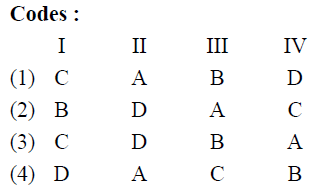
18. Which one of the International Conferences brought together the values and ideas of 1500 women from the North and the South and recognized women’s integral role in environmental Management and outlined ways to achieve a sustainable world with the help of women.
(1) Beijing Conference
(2) Rio-de-Janerio Conference
(3) Stockholm Conference
(4) Paris Agreement
19. Which of the following are the component indicators of “The Global Hunger Index” ?
I. The proportion of children under the age of five suffering from Vitamin A deficiency.
II. The proportion of children under the age of five suffering from wasting.
III. The proportion of children under the age of five suffering from stunting.
IV. The mortality rate of children under the age of five.
Codes :
(1) I, II, III and IV are correct.
(2) I, II and III are correct.
(3) I and IV are correct.
(4) II, III and IV are correct.
20. Match List-I with List-II.
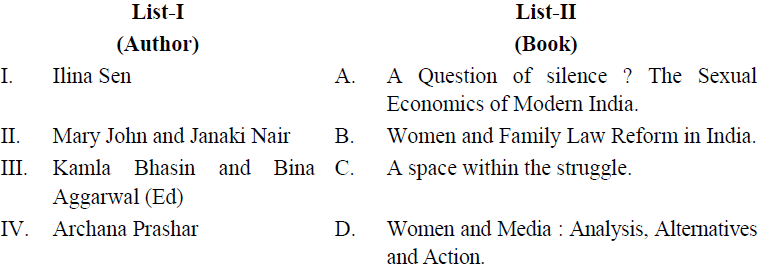
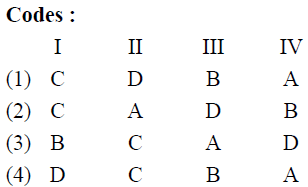
21. Among the following feminists who believed that the biologists, psychologists and Marxists have to say about the causes and reasons for woman’s condition, but none of them truly explain, why women not man is the other.
(1) Simone de Beauvoir
(2) Harriyet Taylor
(3) Nancy Chowdrow
(4) Shulamith Firestone
22. Gap between urban/rural female literacy rate in India as per 2011 census is
(1) 20.17 per cent
(2) 21.07 per cent
(3) 21.17 per cent
(4) 22.4 per cent
23. Which of the following suits or proceedings come under the Jurisdiction of the Family Courts Act, 1984 ?
I. For declaration as to the validity of a marriage or as to matrimonial status of a person.
II. Between the parties to a marriage with respect to the property of the parties or of either of them.
III. For a declaration as to the illegitimacy of any person.
IV. For maintenance.
Codes :
(1) I, II and IV
(2) I, II and III
(3) II, III and IV
(4) I, II, III and IV
24. Match the List-I with List-II according to the Census of India 2011.

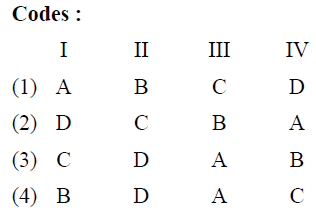
25. In which research technique, there is more involvement of the researcher with the researched ?
(1) Questionnaire
(2) Participant observation
(3) Interview method
(4) Interview guide
26. Which Article of the Constitution of India requires the state to endeavour to secure for the citizens a Uniform Civil Code ?
(1) Article 42
(2) Article 44
(3) Article 45
(4) Article 46
27. Assertion (A) : Gender equality means accepting and valuing equally the differences between women and men and the diverse roles they play in the society.
Reason (R) : Gender sensitization programme has not brought positive changes to achieve gender equality in the society.
Which one of the following is correct ?
Codes :
(1) Both (A) and (R) are true and (R) is the correct explanation of (A).
(2) Both (A) and (R) are true, but (R) is not the correct explanation of (A).
(3) (A) is true, but (R) is false.
(4) (A) is false, but (R) is true.
28. Match the List-I with List-II of following :
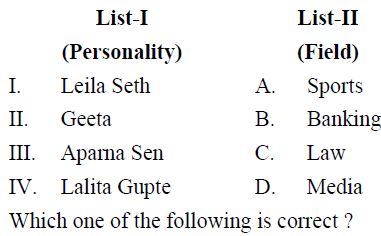

29. Who was the Minister of Women and Child Development when the National Policy on Empowerment of Women was framed ?
(1) Renuka Choudhary
(2) Krishna Tirath
(3) Menaka Sanjay Gandhi
(4) Sumitra Mahajan
30. As per ‘Sukanya Samridhi Yojana’, the parents of girl children can open an account for a girl child up to the age of
(1) 5 years
(2) 10 years
(3) 15 years
(4) 18 years
31. Who among the following set up a radio transmitter called “The Voice of Freedom” to disseminate Gandhiji’s message during Quit India Movement ?
(1) Aruna Asaf Ali
(2) Usha Mehta
(3) Sarojini Naidu
(4) Annie Besant
32. Find out the correct sequence concerning various steps to conduct research effectively :
I. Developing hypothesis
II. Data analysis
III. Preparation of report
IV. Formulating research problem
Codes :
(1) III, II, I, IV
(2) I, II, III, IV
(3) II, IV, I, III
(4) IV, I, II, III
33. Which of the following International Conference was marked by a growth of networks linking women’s activism at the local and global levels ?
(1) Mexico City Conference
(2) Copenhagen Conference
(3) Nairobi Conference
(4) Beijing Conference
34. The 2016 Women Economic Forum (WEF) has been hosted by which of the following countries ?
(1) Brazil
(2) India
(3) South Africa
(4) Russia
35. Which of the following terminology is correct according to the “Indecent Representation of Women (Prohibition) Act”, 1986 ?
I. An “advertisement” include any notice, circular label, wrapper or other document.
II. “Distribution” includes distribution by way of material sold only.
III. An “advertisement” include any visible representation made by means of any light, sound, smoke or gas.
IV. “Package” includes a box, carton, tin or any container.
Codes :
(1) I,II, III and IV
(2) I, II and III
(3) I, II and IV
(4) I, III and IV
36. Which of the following is correct that during the ancient Olympic Games ?
(1) Only the married women could participate in or watch the games.
(2) Only unmarried women could watch the games.
(3) Women were not allowed to watch the games.
(4) Women with their husbands alone were allowed to watch the games.
37. Which research design aims at finding out the possibility of conducting research and formulation of hypothesis ?
(1) Diagnostic
(2) Descriptive
(3) Experimental
(4) Exploratory
38. Assertion (A) : Sexual harassment at work place is a personal problem of women.
Reason (R) : Women keep silent about sexual harassment to protect the perpetrator.
Which of the following is correct ?
Codes :
(1) Both (A) and (R) are true.
(2) (A) is false and (R) is true.
(3) (A) is true and (R) is false.
(4) Both (A) and (R) are false and (R) is not the correct explanation of (A).
39. In which year the Global Gender Gap Index was first introduced ?
(1) 2002
(2) 2004
(3) 2006
(4) 2007
40. Which of the following was a significant event in the bay Rights moment ?
(1) Seneca falls
(2) Stonewall Riots
(3) Declaration of Sentiments
(4) Beaumont Race Riots
41. Which one of the following pair is correctly matched ?

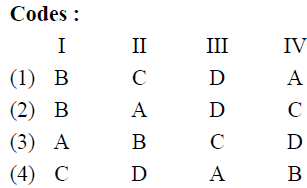
42. Which of the following is not a function of the National Commission for Women ?
(1) Advice on the planning process of socio economic development of women.
(2) Functions like a civil court.
(3) Examination of all matters related to safeguards provided for women under the constitution and other laws.
(4) Fund the litigation involving issues affecting a large body of women.
43. Arrange chronologically the Schemes/Acts according to the year of establishment :
I. Juvenile Justice Act
II. Commission for Protection of Child Rights Act
III. Integrated child protection scheme.
IV. The protection of children from sexual offences.
Codes :
(1) I, II, III, IV
(2) I, II, IV, III
(3) II, I, IV, III
(4) I, III, II, IV
44. Who has been named as the most powerful woman in technology on the Forbes’ 100 most powerful women list ?
(1) Indra Nooyi
(2) Sheryl Sandberg
(3) Chanda Kochhar
(4) Ginni Rometty
45. What does formation of an All India Group by the name of National Federation of Dalit Women Symbolize ?
I. Invisibility of Dalit Women.
II. Dalit Women’s perception of exclusion from the main stream.
III. Legal inequalities.
IV. Caste-based inequalities.
Codes :
(1) I, II, IV
(2) II, III, IV
(3) I, II, III, IV
(4) I, III, IV
46. Which one of the following pairs is correctly matched ?
Match the List-I with List-II.
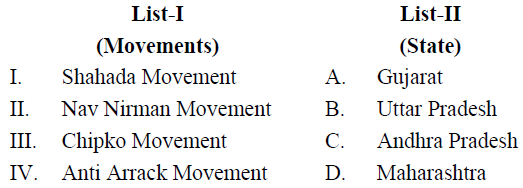
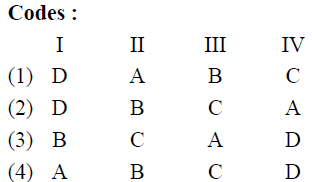
47. Which of the following schemes encourage parents to build a fund for the feature education and marriage expenses for their girl children.
(1) Kishori Samriddhi Yojana
(2) Janani Surakha Yojana
(3) Sukanya Samriddhi Yojana
(4) Sabala Samriddhi Yojana
48. Who said that men’s relationship with nature was predatory from the beginning and in his lust for power, man establishes a similar relationship with women who seemed to be like nature ?
(1) Maria Mies
(2) Simon de Beauvoir
(3) Medha Patkar
(4) Robin Morgan
49. R.W. Connell’s theory of the gender hierarchy identifies many expressions of Femininity and Masculinity. Which one sets at the top of the hierarchy ?
(1) Complicit Masculinity
(2) Hegemonic Masculinity
(3) Emphasised Femininity
(4) Complicit Femininity
50. Which of the following is an approach/strategy for Women In Development (WID).
I. An approach which views women’s lack of participation of the problem.
II. Integrate women into existing structures.
III. Increase women’s ability to manage the household.
IV. Address unequal relations between women and men for equitable development.
Codes :
(1) I, II, III and IV are correct.
(2) I, II and IV are correct.
(3) I and II are correct.
(4) I, II and III are correct.






















